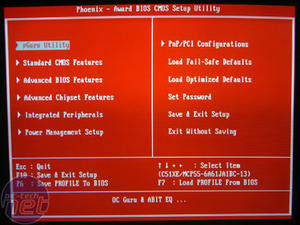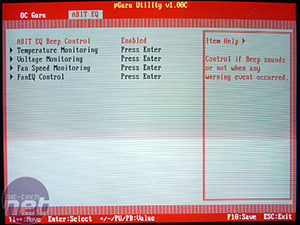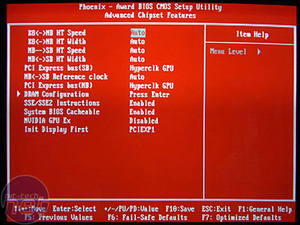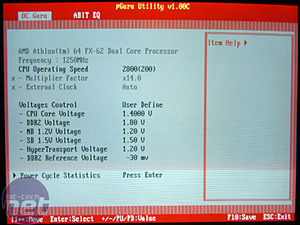
The two fans can be unplugged and removed which frees up the space for other things (a mod project?) or other fans since they use universal 3-pin connectors.
BIOS




Voltage Adjustments: CPU Voltage (1.4V to 2.175V in ?V increments); C51 northbridge voltage (1.20V to 1.5V in ?V increments); MCP55 southbridge (1.50V to 2.0V in ?V increments); HyperThreading (1.20V to 1.35V in ?V increments); Memory (1.75V to 2.3V in ?V increments); DDR2 reference voltage (-60mV to +60mV in 10mV increments);
Memory Timings:Command Rate, Tcl (CAS), Tras (Row Active Strobe Time), Trcd (Row Address to Column Address Delay), Twtr (Internal Write to Read Command Delay), Trfc0, Trfc1,Trfc2,Trfc3 (Row cycle refresh time: microsecs per DIMM), Trc (Row Cycle Time), Trp (Row Precharge Time), Trtp (Read to Precharge Delay), Read DQS Skew/Timing;
Other Inclusions: Abit uGuru Temperature, Voltage and Fan monitoring as well as the FanEQ system which regulates fan speed according to temperature.
Whilst the Abit AW9D-MAX BIOS was black the Fatal1ty AN9 32X offers a rather fetching blood red attire that will either make you fall in love or cause your eyes to bleed. No, it's really not that bad as long as your TFT brightness isn't scaled to the levels of retinal damage and your colour representation is correctly configured.
There's detailed support for a large quantity of BIOS timings, more so than the Abit AW9D-MAX offers and almost comparable to the recent DFI LanParty UT NF590 SLI M2R/G we reviewed. Since this was designed pre-AW9D-MAX there's no BIOS option to turn off or even just stop the red lights from flashing and instead have them on constantly.
Hefty voltage increments can be found across the board, with a potentially CPU terminal 2.1V+ being offered. Despite the fact there's "only" a 2.3V vDIMM reference voltage, Abit also offers a "memory voltage offset" ranging from -60mV to +60mV. This is in addition to the core memory voltage, which adds or subtracts to the overall voltage passed through your DIMM modules.

MSI MPG Velox 100R Chassis Review
October 14 2021 | 15:04






Want to comment? Please log in.